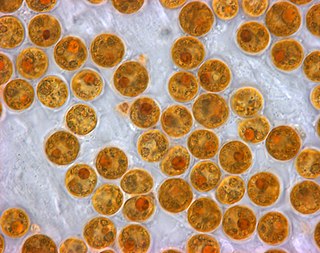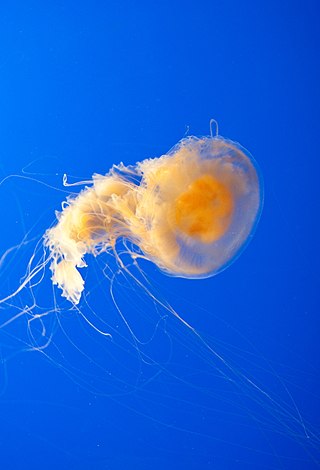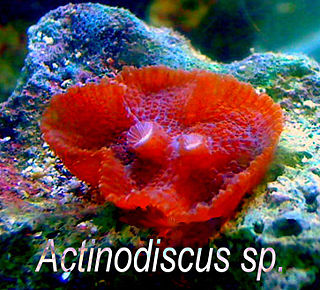
Cnidaria is a phylum under kingdom Animalia containing over 11,000 species of aquatic animals found both in freshwater and marine environments, including jellyfish, hydroids, sea anemone, corals and some of the smallest marine parasites. Their distinguishing features are a decentralized nervous system distributed throughout a gelatinous body and the presence of cnidocytes or cnidoblasts, specialized cells with ejectable flagella used mainly for envenomation and capturing prey. Their bodies consist of mesoglea, a non-living jelly-like substance, sandwiched between two layers of epithelium that are mostly one cell thick.

The Scyphozoa are an exclusively marine class of the phylum Cnidaria, referred to as the true jellyfish.

Zooxanthellae is a colloquial term for single-celled dinoflagellates that are able to live in symbiosis with diverse marine invertebrates including demosponges, corals, jellyfish, and nudibranchs. Most known zooxanthellae are in the genus Symbiodinium, but some are known from the genus Amphidinium, and other taxa, as yet unidentified, may have similar endosymbiont affinities. The true Zooxanthella K.brandt is a mutualist of the radiolarian Collozoum inerme and systematically placed in Peridiniales. Another group of unicellular eukaryotes that partake in similar endosymbiotic relationships in both marine and freshwater habitats are green algae zoochlorellae.

Cassiopea is a genus of true jellyfish and the only members of the family Cassiopeidae. They are found in warmer coastal regions around the world, including shallow mangrove swamps, mudflats, canals, and turtle grass flats in Florida, and the Caribbean and Micronesia. The medusa usually lives upside-down on the bottom, which has earned them the common name. These jellyfish partake in a symbiotic relationship with photosynthetic dinoflagellates and therefore, must lie upside-down in areas with sufficient light penetration to fuel their energy source. Where found, there may be numerous individuals with varying shades of white, blue, green and brown.

The aggregating anemone, or clonal anemone, is the most abundant species of sea anemone found on rocky, tide swept shores along the Pacific coast of North America. This cnidarian hosts endosymbiotic algae called zooxanthellae that contribute substantially to primary productivity in the intertidal zone. The aggregating anemone has become a model organism for the study of temperate cnidarian-algal symbioses.

Phacellophora camtschatica, commonly known as the fried egg jellyfish or egg-yolk jellyfish, is a very large jellyfish in the family Phacellophoridae. This species can be easily identified by the yellow coloration in the center of its body which closely resembles an egg yolk, hence how it got its common name. Some individuals can have a bell close to 60 cm (2 ft) in diameter, and most individuals have 16 clusters of up to a few dozen tentacles, each up to 6 m (20 ft) long. A smaller jellyfish, Cotylorhiza tuberculata, typically found in warmer water, particularly in the Mediterranean Sea, is also popularly called a fried egg jellyfish. Also, P. camtschatica is sometimes confused with the Lion's mane jellyfish.

Cotylorhiza tuberculata is a species of jellyfish of the phylum Cnidaria, also known as the Mediterranean jellyfish, Mediterranean jelly, or fried egg jellyfish. It is commonly found in the Mediterranean Sea, Aegean Sea, and Adriatic Sea.

The spotted jelly, lagoon jelly, golden medusa, or Papuan jellyfish, is a species of jellyfish from the Indo-Pacific oceans. Like corals, sea anemones, and other sea jellies, it belongs to the phylum Cnidaria. Mastigias papua is one of the numerous marine animals living in symbiosis with zooxanthellae, a photosynthetic alga.

The snakelocks anemone is a sea anemone found in the eastern Atlantic Ocean and the Mediterranean Sea. The latter population is however sometimes considered a separate species, the Mediterranean snakelocks anemone.

Discosoma is a genus of cnidarians in the order Corallimorpharia. Common names for the genus include mushroom anemone, disc anemone and elephant ear mushroom.

Anthopleura ballii, commonly known as the red speckled anemone, is a species of sea anemone in the family Actiniidae. It is found in shallow water in the northeastern Atlantic Ocean.

Cassiopea xamachana, commonly known as the upside-down jellyfish, is a species of jellyfish in the family Cassiopeidae. It is found in warm parts of the western Atlantic Ocean, the Caribbean Sea, and the Gulf of Mexico. It was first described by the American marine biologist Henry Bryant Bigelow in 1892.

The thimble jellyfish is a species of cnidarian found in the warm West Atlantic Ocean, including the Caribbean. It is a tiny jellyfish with a straight-sided, flat-topped bell. This jellyfish is the most common cause of seabather's eruption, a reaction caused by the injection of juvenile jellyfish nematocysts into human skin.

Rhopilema verrilli, or mushroom cap jellyfish, is a species of jellyfish in the family Rhizostomatidae. They are cnidarian invertebrates distinguished by their mushroom-shaped medusae. The species does not have any tentacles; however, they still have stinging cells, called nematocysts, within their bells, which can produce mild stings to humans.

The South American sea nettle is a species of jellyfish from the family Pelagiidae. It is found from the Pacific coast of Peru, south along Chile's coast to Tierra del Fuego, and north along the Atlantic coast of Argentina, with a few records from Uruguay. Despite its common name, it is not the only sea nettle in South America. For example, C. lactea is another type of sea nettle in this region. Historically, C. plocamia was often confused with C. hysoscella, a species now known to be restricted to the northeast Atlantic. C. plocamia is a large jellyfish, up to 1 m in bell diameter, although most mature individuals only are 25–40 cm (10–16 in).

Atorella is a genus of crown jellyfish. It is the only genus in the monotypic family Atorellidae and includes five species. Members of this family are known from the eastern coast of Africa and the western coast of Panama.

Cassiopea ornata are one of many Cnidarian species called the upside-down jellyfish. This pelagic jellyfish primarily lives in tropical waters, off the coast of Australia in shallow lagoons and around mangrove trees. The name "upside-down jellyfish" comes from the fact that it appears to be upside-down in its natural state—resting on its bell. Its bell is a golden/brown color and the tentacles vary with different shades of yellow. While the sighting of this particular species is rare, it is usually mistaken for vegetation like the other species in genus Cassiopea.

Cephea cephea, also known as the crown jellyfish, or cauliflower jellyfish, is a species of jellyfish in the family Cepheidae. It occurs in the tropical waters of the western Indo-Pacific to Northern Australia. The species was first described by Peter Forsskål in 1775 and originally given the name Medusa cephea. It inhabits the pelagic zone of tropical and sub-tropical waters and is most commonly found in the Indo-West Pacific, eastern Atlantic and the Red Sea. Although this species is among the most venomous jellyfish, it is not harmful to humans and is eaten as a delicacy and used for medical purposes in China and Japan. The species can achieve a diameter of up to 60 cm.

Versuriga is a monotypic genus of jellyfishes belonging to the monotypic family Versurigidae. The only species is Versuriga anadyomene. This species is rare, only having been sighted in a limited region. However, it can be identified by its gradient-like coloration, as well as its umbrella shaped bell, which is common amongst other members of the class Scyphozoa. This species is important for many reasons, ranging from ecological interactions to socioeconomic benefits. Notably, Versuriga is able to form commensalistic relationships with other organisms, impacting biodiversity, as well as being a food source for humans and other predators.



















